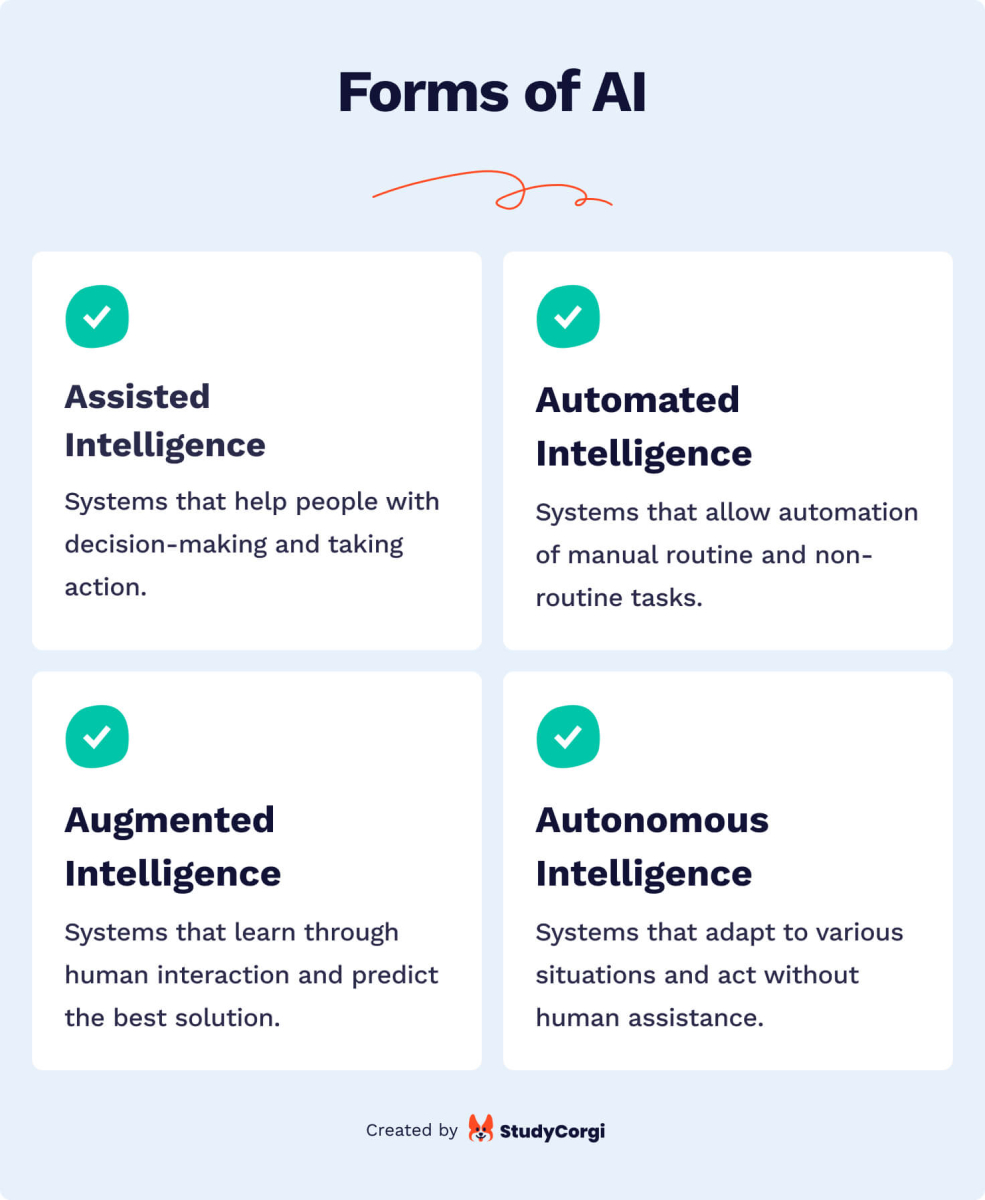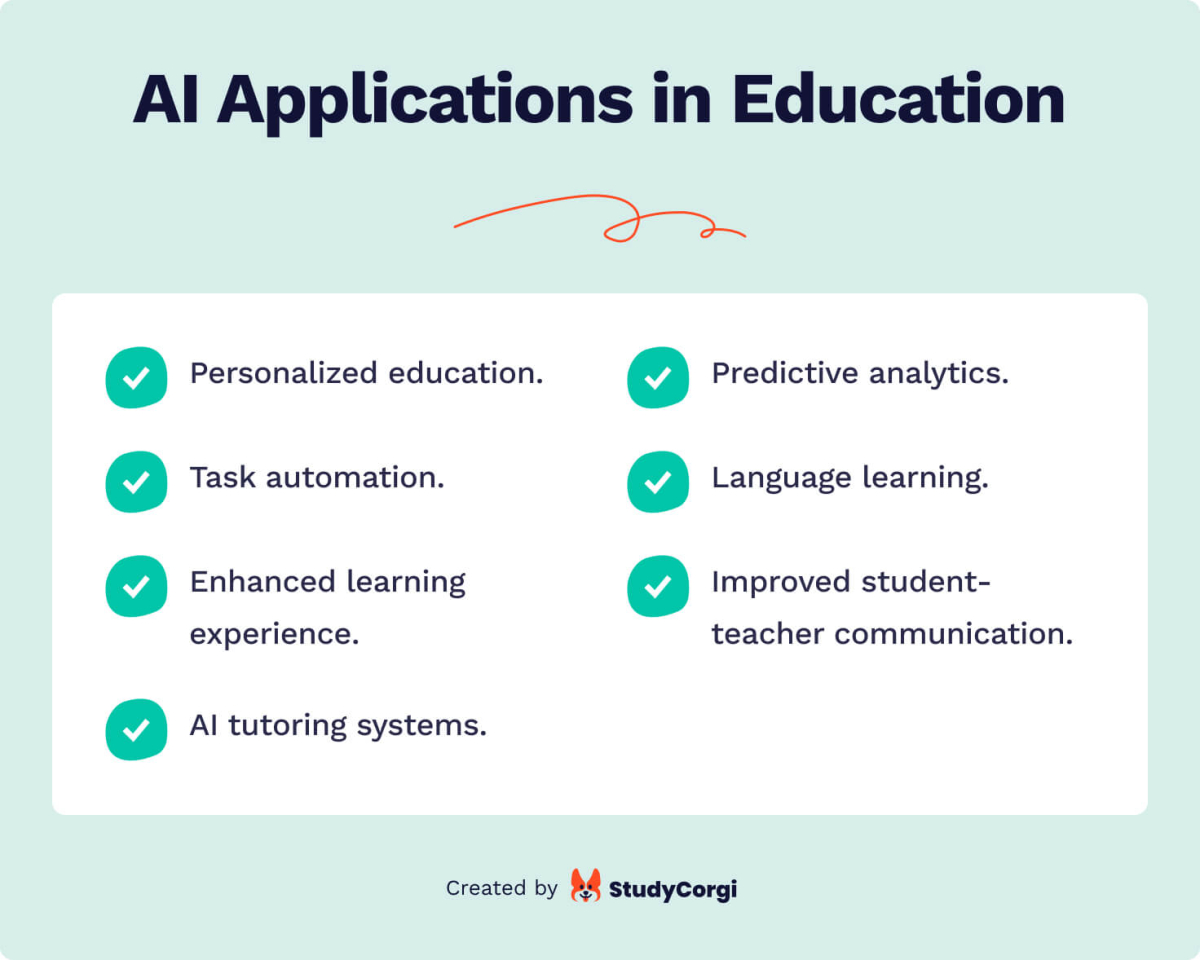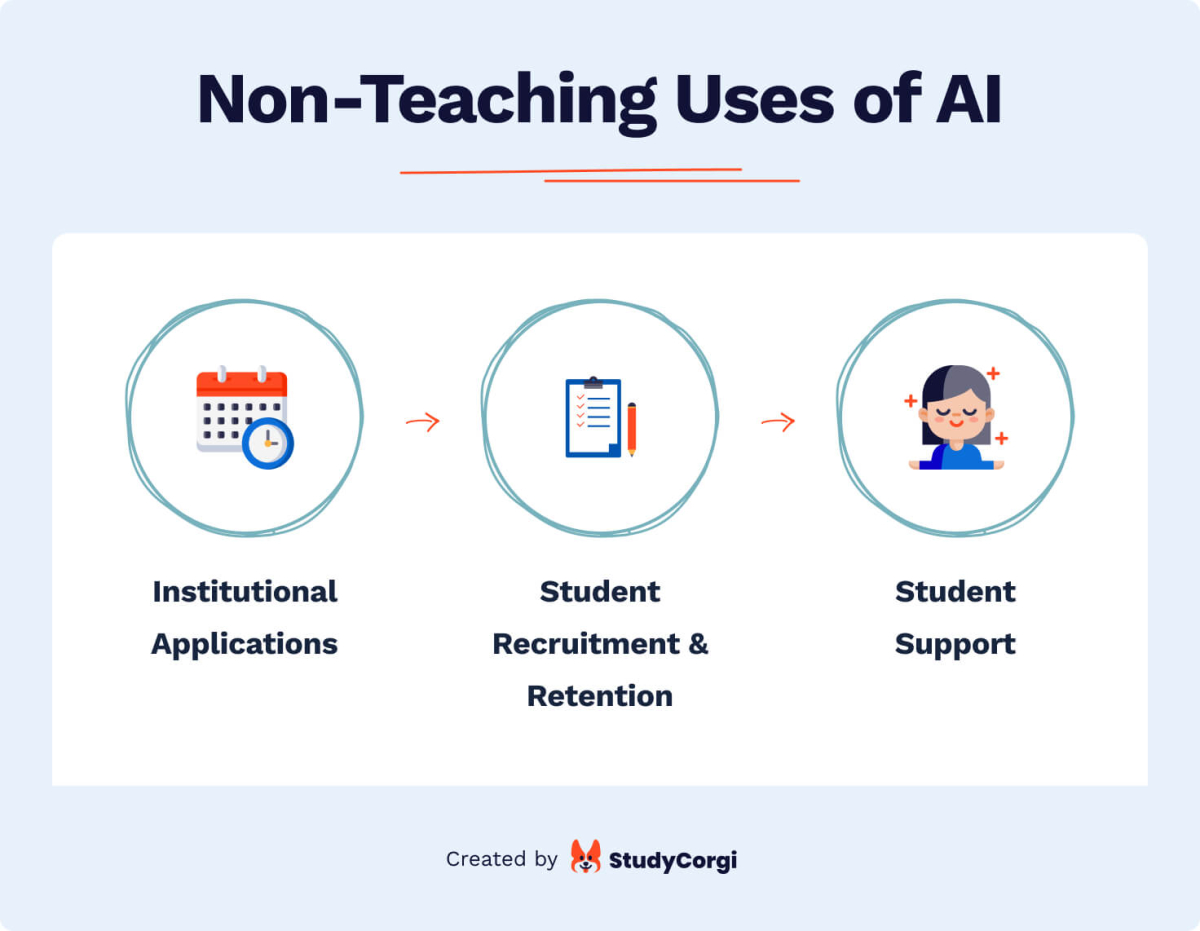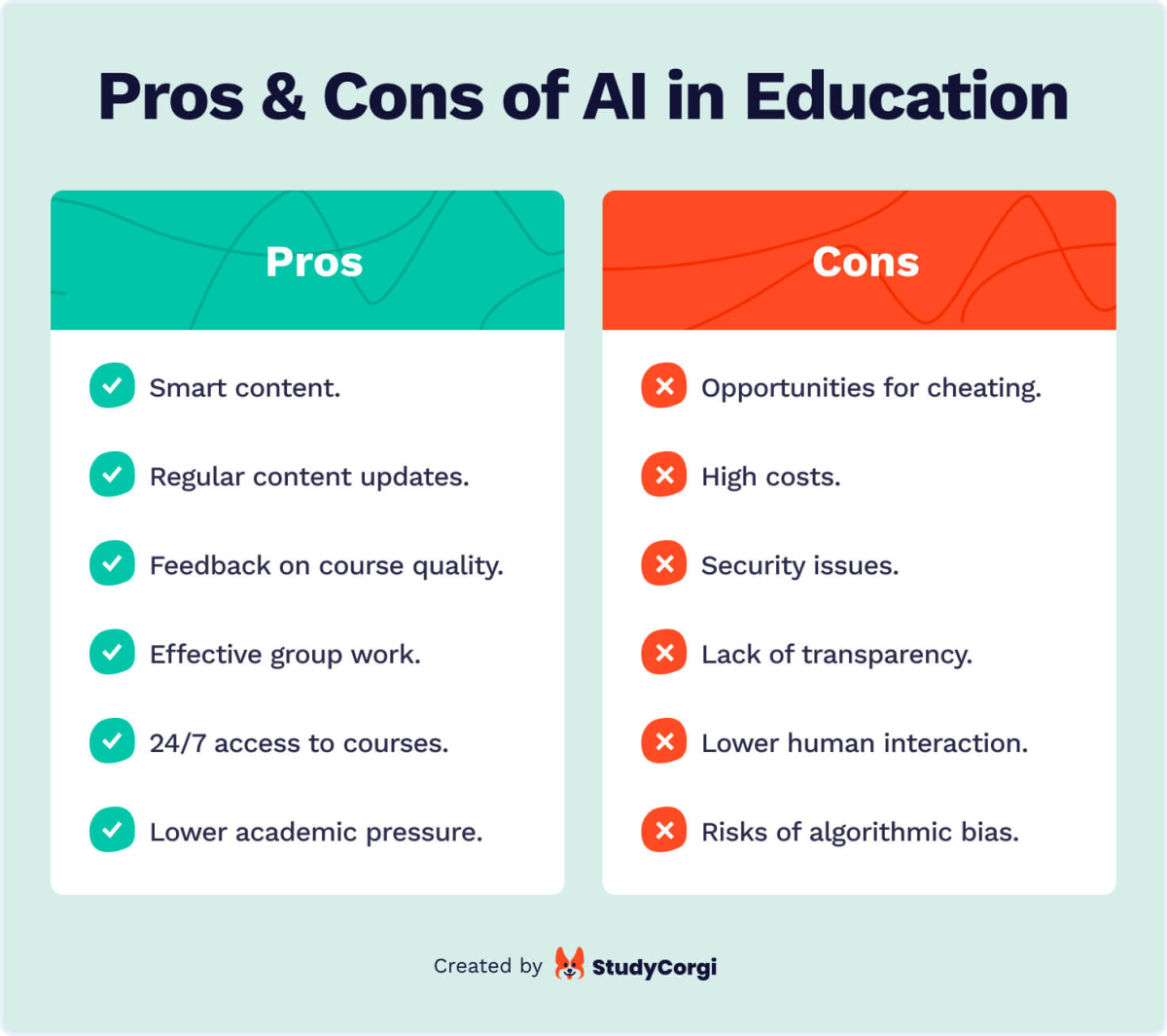StudyCorgi

Did you know that the global market size of AI in education was valued at 1.82 billion dollars in 2021? Covid-19 fueled the demand for new AI-based education solutions, and the popularity of AI in education is expected to grow. There is reason to be excited about such tools because they provide more opportunities for personalized learning, better student-teacher communication, real-time feedback, and many more benefits.
This article will cover the key pros and cons of AI tools in education and provide examples of how you can use AI for your studies. And don’t miss our free essay samples, which will also help you with your classes.
🔤 What Is Artificial Intelligence in Education?
Many technologies can be understood under the umbrella term of artificial intelligence. Simply put, AI simulates human intelligence processes via computer systems. AI tools require specialized hardware and software, such as machine learning. Machine learning works by receiving large amounts of training data, analyzing that data for patterns and correlations, and using the findings to predict future outcomes.
According to the PwC AI report, most AI tools fall into 4 categories: assisted intelligence, automated intelligence, augmented intelligence, and autonomous intelligence.

All four groups of AI technologies create new educational opportunities that we’ll discuss below.
🔝 Top 5 Examples of AI in Education
There are many innovative ways in which AI can benefit students and educators. Here are some recent real-life examples.
1. Staffordshire University launched the first digital assistant for students. Staffordshire University designed Beacon, the smartphone app, to help students navigate their daily lives on campus. The app supports students’ learning, checks their moods, and analyzes their interests to recommend groups and clubs to join.
2. GSU created a chatbot for students with personalized content. Georgia State University launched a virtual assistant, Pounce, to guide students through admission. Pounce sends timely reminders and relevant information about enrollment documents. The chatbot also immediately answers students’ questions so they don’t feel judged for asking what might feel “stupid.”
3. SNHU started using Google AI for individualized tutoring and counseling. Southern New Hampshire University has nearly 150,000 exclusively online students. They work on the Google AI tutor platform that generates learning activities students can access on the app. The platform provides coaching for different types of tasks and advises them on academic courses based on their prior knowledge, interests, and career goals.
4. The Massachusetts DESE launched an Early Warning Indicator Index. The Massachusetts Department of Elementary and Secondary Education introduced a statistical model for the Early Warning Indicator Index System (EWIS). EWIS identifies students at risk of failing to reach their age-appropriate developmental milestones and dropping out. Then these students get help from teachers and the school administration to ensure they graduate successfully.
5. US colleges started using Turnitin to grade students’ papers. About 15,000 institutions worldwide have used Turnitin, a web-based text system that checks writings for citation mistakes and plagiarism. Recently, Turnitin’s technologies were trained to detect text produced by AI chatbots, such as ChatGPT.
👩🏫 How Is AI Used in Education?
Educators can use AI in many ways to optimize routine tasks and provide opportunities for personalized learning. Here are some of the most promising AI applications.

Personalized Education
Personalization is one of the most significant educational trends. AI can customize the learning approach depending on a student’s preferences, learning style, knowledge level, and goals.
For example, the University of Bath conducted an experiment where participants took a data science course powered by the AI tutor Korbit. Korbit interacted with students in real time and adapted the content to their performance and pace. The researchers observed that students with AI tutors had 2 to 2.5 times higher learning gains than those without.
Intelligent Tutoring Systems
Personal tutoring outside the classroom has always helped learners to keep up with their courses. AI technologies bring tutoring to the next level, providing students individual support 24/7. AI tutors not only save teachers time by explaining challenging topics but also help students to avoid the embarrassment of asking too many questions.
One of the recent AI technologies for tutoring you must have heard of is ChatGPT. You can use this chatbot for personal assistance, such as finding information on a topic, checking your writing, or generating essay ideas.
Task Automation
Administrative tasks like grading, assessing, and replying to emails are time-consuming. However, with the help of AI tools, teachers can optimize them and have more time for interaction with students. AI technologies now allow teachers to generate lesson plans, automatically check tests, provide instant feedback, and much more.
One of the most popular AI solutions for teachers is called Gradescope. Gradescope is an online grading tool for scanned, pen-and-paper, free-response tasks. The tool makes it easy to organize, grade, and provide detailed feedback on assignments and tests.
Language Learning
Plenty of language resources and tools are available. However, soon after students decide to learn a foreign language, their engagement usually drops since they often lack the motivation to continue their studies. But there’s hope that AI can be integrated into language learning apps to fuel engagement. AI tools for language learning have numerous benefits, such as providing instant feedback, eliminating the fear of mistakes, and personalizing the language learning process.
The most popular language app Duolingo has already incorporated an AI chatbot that users can text with to improve their skills. Learners can even send voice messages, and the chatbot will correct their pronunciation.
Predictive Analytics
Simply put, predictive analytics uses historical data to identify the likelihood of future outcomes. Predictive analytics relies on various statistical techniques, modeling, and artificial intelligence to make forecasts as precise as possible. In education, it helps reduce the number of college dropouts, analyze student and staff feedback, and identify the latest educational trends.
For example, in Tacoma, Washington, the administration increased high school graduation rates from 55% to 78% between 2010 and 2014 with the help of predictive analytics. AI identified students at risk of dropping out so that the school could provide the necessary support.
Enhanced Learning Experience
AI technologies, VR, and 3D simulations add emotional components to traditional learning contexts, offering many opportunities to motivate students. These tools enable learners to engage in highly specific situations without time and cost constraints.
For example, in 2022, the University of North Carolina at Charlotte introduced the Anatomage Table, the most technologically advanced 3D virtual anatomy visualization tool. It takes the form of a high-tech tablet the size of an operating bed and presents three-dimensional and life-sized images of body samples. With the help of this technology, medical students have access to accurate 3D anatomy.
Improved Student-Teacher Communication
Teaching involves forming meaningful relationships with students and communicating effectively. Such conditions allow students to learn the course content and work on their soft skills. AI can foster teacher-student connection by detecting when students get confused and providing support when learners need it.
One more way AI can benefit student-teacher relationships is through virtual avatars. During online classes, these stylized 3D pictures help maintain students’ attention and give them freedom for self-expression.
📅 Non-Teaching Uses of AI in Education
Besides the educational process, AI is helpful with administrative tasks. We’ve come up with several examples of how this technology optimizes school organizational activities.

Institutional Applications
Schools, especially in higher education, widely use AI for marketing to prospective students, planning schedules, estimating class size, and allocating financial aid. AI-powered tools manage the scheduling of classes, courses, rooms, equipment, and exams.
Moreover, AI allows universities to improve recruitment processes and procurement systems. 52% of HR specialists agree that the most challenging part of recruitment is screening candidates from a large applicant pool, and AI helps to tackle this challenge. As for campus spending and services, there are AI assistants that make it easier for colleges to get the supplies they need.
Student Recruitment and Retention
Colleges use various artificial intelligence tools to improve enrollment and retention rates. For example, recruiting teams now use algorithms that can predict the applicants most likely to be accepted and enrolled and the states and countries from which they originate. With the help of AI, college administrations can also address the issue of “summer melt,” identifying applicants who paid a deposit but may not enroll in September.
With the help of an AI chatbot, Georgia State University reduced “summer melt” by 22%. The chatbot sends students timely reminders and relevant information about the college and instantly answers their questions to maintain students’ interest.
Student Support
Many schools nowadays use artificial intelligence in student guidance to automatically schedule their classes and recommend courses, majors, and career paths. The AI tools make recommendations based on how students with similar data profiles performed in the past.
However, one of the most significant advantages of AI in education might be the opportunity to screen for eating disorders, self-harm, and drug abuse. For example, JUNO AI, an advanced video analytics platform, provides insights into students’ behavior and emotional states. JUNO AI enables schools to better assess students’ mental health needs without compromising student privacy.
🦻🏽 AI in Special Education
One of the most outstanding achievements of AI in education is that it assists students with disabilities. Consider the examples below to learn how AI provides equal learning opportunities to students with special needs.
Early Detection of Learning Disabilities
The Eunice Kennedy Shriver National Institute of Child Health and Human Development lists the following learning difficulties:Dyslexia.
Dysgraphia.
Dyscalculia.
Central auditory processing disorder.
Apraxia of speech.
Nonverbal learning disorders.
Recent statistics show about a third of US students with disabilities have one of these learning difficulties. Another group of students who often need assistance to keep up with their studies includes those with ADHD. More than 9% of children between the ages of 2 to 17 in the US have this diagnosis.
Luckily, AI-based systems help detect learning disabilities at an early stage. Computer algorithms process massive amounts of cognitive testing data, including measures of listening skills, spatial reasoning, problem-solving, and memory. This information is then used to identify specific disabilities so that students can get the support they need.
Improved Accessibility
Students with disabilities often experience educational barriers that they can overcome with the help of assistive technologies. Artificial intelligence has many promising applications that can create a more accessible learning environment.
For example, there are advanced speech synthesis technologies that transform any text into a clear speaking voice. Moreover, visually impaired students can now use AI assistants that automatically describe images. One more example involves tools like Apple Siri and Amazon Echo that allow interaction with the content on their websites through dialogues. Students can ask the virtual assistant to read aloud the headings on a page, explain how the page is structured, or skip irrelevant content.
Adaptive Learning
Students with learning disabilities process information at a different pace and often need personalized instructions from a teacher. The key to a student’s individualized education is artificial intelligence — more specifically, adaptive learning.
Adaptive learning is a technology that adjusts the educational process to a student’s needs. The program analyzes the student’s progress and interactions to determine what works best and modifies the curriculum and assessment format. With adaptive learning technology, students’ tasks can always cater to their learning style.
⚖️ Pros and Cons of Artificial Intelligence in Education
Though many schools have already incorporated AI in their educational process, some educators and parents still don’t trust the new technologies. In this section, we’ll examine the pros and cons of introducing AI into education.

Benefits of Artificial Intelligence in Education
The key benefits of artificial intelligence in education include the following:It helps create smart content. Using AI, teachers can easily develop digital lessons with customization options and study guides that raise students’ engagement.
It ensures the learning content is up-to-date. AI enables educators to generate and update lesson content with the most relevant information.
It provides feedback on course quality. AI can detect instruction gaps in the course content and possible challenges based on student performance.
It increases the efficiency of group work. AI can generate groups that balance one student’s weaknesses with another student’s strengths.
It makes learning accessible 24/7. With AI assistants, students have online access to learning, so they can study on the go or at any place and time they want.
It reduces academic pressure. Personalized lessons allow students to stop comparing themselves to each other.
Disadvantages of Artificial Intelligence in Education
It’s important to know certain risks associated with using AI for studies. Consider the following drawbacks:It creates more opportunities for cheating. Implementing AI tools like ChatGPT allows students to generate original human-like writings.
It is quite costly. Designing AI technology for education requires plenty of time and resources, which drives the prices up. In addition, schools have to procure the latest hardware and software to operate this technology.
It may lead to security issues. Without proper protection, students’ data collected by AI can be hacked and misused.
It lacks transparency. Often educators don’t fully understand the mechanisms behind AI tools and cannot explain these processes to students.
It decreases human interaction. Since AI gadgets have no feelings, students cannot form emotional connections essential for effective learning.
It remains at risk of algorithmic bias. Since AI technologies are trained on human-produced data, the outcomes can contain gender, age, race, and other biases.
🧰 Best AI-Powered Tools for Students
If you wonder what AI tools you can try for your studies now, keep reading. We’ve listed the most popular and convenient AI technologies for students.
AI Writing Assistants
Writing academic texts or online content can be time-consuming unless you use AI tools. Here are the most popular tools that you can use to scan your text for grammar and style mistakes.
Rytr Rytr is an AI writing assistant that helps creators produce high-quality content in just a few seconds. The tool can develop a catchy essay or blog idea, write an engaging introduction, or add relevant keywords to your text. Price: $29/month.
Grammarly Grammarly is one of the best-known writing assistants that ensures your text has accurate spelling, punctuation, and grammar and that the structure is clear and easy to read. Price: $30/month for Premium.
StudyCorgi Essay Reworder Essay Reworder is an AI-powered tool that allows you to paraphrase a text in a few clicks. You can choose the text percentage to reword and enjoy fully original writing. Price: Free.
AI Tools for Studying
AI technologies are helpful when it comes to test and exam preparations. They help summarize the material and structure it for you to remember easily. Here are the tools we recommend checking out.
Explain Like I’m Five Explain Like I’m Five is a web application that simplifies topics so a 5-year-old child can understand them. The website can help you with exam preparation because it can explain the most abstract concepts in simple words. Price: $3.99/month.
Quizlet Quizlet is a free website that provides smart learning decisions for students. You can study for a test with the help of Quizlet flashcards, games, and expert-developed memorization methods. Price: Free.
StudyCorgi Summary Generator This summary generator allows users to reduce any text down to the main ideas. You can choose the number of sentences you want in your summary and quickly process a large amount of text. Price: Free.
AI-Powered Language Learning Apps
AI technologies can also become a great assistant in language learning. They make the process more engaging by adapting the tasks to learners’ interests and pace. Here are some examples of AI-powered tools.
Memrise Memrise enables users to learn languages in real-world contexts. The website personalizes a learning course based on users’ preferences and allows them to practice speaking with their AI conversation partner, MemBot. Price: $8.49/month.
Duolingo Duolingo offers users quick, bite-sized lessons available on their phone app anytime. It helps form a language learning habit with game-like features and fun challenges that adapt to students’ progress. Price: Free.
Busuu Busuu provides access to compact lessons from experts and native speakers. The interactive smart lessons allow users to practice pronunciation and gain cultural insights in a fun way. Price: €11,99/month.
AI Tools for Students with Learning Disabilities
AI tools can be an excellent solution for students with learning disabilities to improve their academic performance and reduce stress. Consider the following apps.
SnapType Pro SnapType Pro is a helpful app for students with dysgraphia and other learning disabilities. This technology allows users to take snapshots of any worksheet or import them from an email to zoom in, make drawings, or add text effortlessly. Price: $4.99.
Ghotit Ghotit helps people with dyslexia and dysgraphia become independent writers and readers. At Ghotit’s technology’s core are advanced phonetical, grammatical, and context-aware algorithms that help produce error-free text. Price: $199/year.
Web Captioner Web Captioner produces accurate speech-to-text transcription with adjustable fonts, colors, and chroma key backgrounds. These features help students with hearing impairment comprehend information and people with ADHD stay focused. Price: Free.
AI Productivity Tools
If you want to boost your productivity, try these AI-powered technologies.
Genei The Genei extension automatically summarizes the main points of blogs, articles, and reports. It paraphrases complex ideas and enables users to find relevant information faster. Price: £3.99/month.
Futurenda Futurenda is an automatic task planner that enables people to manage their time more efficiently. Futurenda monitors users’ deadlines and adjusts their agenda accordingly. Price: Free.
StayFocusd StayFocusd is an extension for Google Chrome that helps you stay focused by restricting your time on time-wasting websites. Price: Free.
🏁 Conclusion
Using AI technologies in education offers essential support to students and enables educators to be more adaptive to learners’ needs and less consumed by routine tasks. The key benefit of AI in education is the ability to provide students with a more personalized learning experience and tailor courses to their individual needs.
However, there are also risks associated with AI, such as security issues and algorithmic bias. When the technologies behind AI systems aren’t transparent, educators and parents can feel apprehensive about letting students use them. One possible solution is to apply artificial intelligence mindfully and continue to investigate the many benefits of its ethical usage.
No comments:
Post a Comment